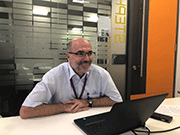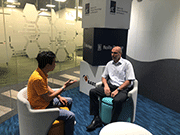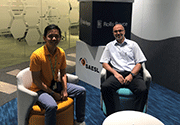E-Archive
Interview
in Vol. 20 - January Issue - Year 2019
One Of The Keynote Speakers For INCASE2019

Thomas Haubold, Manufacturing Engineering and Technology of Rolls-Royce

At Rolls-Royce office

International Conference on Advanced Surface Enhancement (INCASE2019) is jointly organised by ARTC, MFN and Coventry University to catalyse innovation in surface enhancement technologies by bringing together industry practitioners and academics. The conference will be held in Singapore from 10 to 12 September 2019. Register at www.incase2019.com. MFN was able to get an interview with Thomas Haubold, Manufacturing Engineering and Technology of Rolls-Royce.
(?) MFN: Thank you Thomas for your time. Could you start by telling us a little bit about yourself.
(!) T. H.: My name is Thomas Haubold, and I’m married with two grown-up children. My background is materials science, and during my time at university in the 80s, I worked on nanostructured materials. After leaving the institute, I joined Rolls-Royce and have since worked for the company for more than 25 years looking after materials, operations and manufacturing technology. In Rolls-Royce, I have a global function as manufacturing process owner for surface processing. In addition to that, I’m also an engineering associate fellow for special processes. The job involves looking after new perspectives, standards and technology development for the entire Rolls-Royce group. I have to manage internal and external networks to deliver solutions for issues faced in different processes such as shot peening and vibropolishing.
(?) MFN: Can you tell us about major challenges that you face in performing your job?
(!) T. H.: One of the major challenges of holding a global position in a large company like Rolls-Royce is keeping myself up to date with what is happening in the different parts of the company being spread across the world. Working in different time zones (between Asia, North America and Europe) makes it more challenging to get people communicating. Another challenge is to make sure that all the needs of different business units are taken care of and to make the right prioritization for solving issues, as everyone tends to think that his/her problem is the most important. Together with relevant colleagues, we have to make judgement calls for the company to decide which problem to focus on and this can be quite challenging. With the rapid pace of technology development, especially in the digital world, it is also challenging to keep up-to-date with new technologies like measurement techniques, upcoming surface processes, and data-analytics among various other things.
(?) MFN: Can you tell us some exciting developments in the area of surface enhancement and where you think surface enhancement research is heading in the next decade?
(!) T. H.: Shot peening will still be used widely in the future because of its flexibility that allows for broad applications. While we still actively look for alternative processes to introduce compressive stresses on components, I think shot peening will still be the first choice because of its flexibility. One of the key developments in this field will be the use of digital technology such as sensing technology for improved process control and measurement techniques to get rid of the Almen strip in peening finally. We proposed that more than a decade ago, but many people have not believed in that being possible. Now we have come to a point where that idea becomes realistic.
(?) MFN: How about other areas, beside shot peening?
(!) T. H.: If you look at the alternative processes like deep cold rolling, laser or other processes that will create compressive stresses as well as microstructural changes in the surface to extend the life of components, we still need to look at their impacts on different materials. The research direction will be dependent on the new materials being developed and what these materials need in order to meet the design requirement. There might be an ideal process for each material, so it’s hard to predict which process will see what kind of development. We also need to have a better control of these processes as we are also going nearer to the design limits in the industry everywhere. In summary, we need an improved understanding as well as better process control in order to get there.
(?) MFN: You have many experiences in collaborating with universities and institutes for development in surface enhancement. Can you share with us some of the challenges and opportunities that such collaboration presents?
(!) T. H.: There is a number of people and institutions around the world working on these processes. Collaboration is a good opportunity to bring together different views and experiences. The challenge is to find and contact the right partners. We try to utilise the brain power across the world for technology development and find out what is best. That is definitely an opportunity and a challenge. One of the opportunities is of course to use the capability and capacity that already exists rather than recreating this capability internally. We get access to young talent performing the job. Special (surface enhancement) processes are not covered in a standard education, so it's hard to get people with the right experience.
(?) MFN: There are some gaps between scientific research community and industry practitioners. What do you think can be done to minimize this?
(!) T. H.: First of all, the standard problems in operation in the industry may not be very appealing to researchers to investigate due to the lack of scientific rigor. In industries, we often face issues that are a mix of technical, operational, logistics, education and potentially other contributions. Sometimes we may not have communicated well enough to research institutes on the time/effort required from a brilliant idea to be implemented in the industry. In our case for critical parts of an aero engine, it is more than performing some successful experiment or one PhD study. A lot of experimental evidence, statistical studies and demonstrations are needed before we can implement a new process, and this takes years.
It’s a lot of work to carry out before implementation, and we need to share that detail with the scientific community somehow.
(?) MFN: Rolls-Royce has been collaborating with universities very successfully. Can you share with us the Rolls-Royce approach to minimize the gap between universities and industries?
(!) T. H.: Rolls-Royce follows the strategy to work with universities for fundamental research (at low technology readiness level (TRL)). For medium TRL, Rolls-Royce partners with institutes or research centres. To make it successful, we try to leverage on this network as much as possible. Stable, long-lasting cooperation results in research partners being already familiar with our processes and requirements, so that we do not need to go through the process of explaining that every two or three years.
(?) MFN: As an industry practitioner what are you looking out for in research programs carried out in universities or institutes?
(!) T. H.: There are in principle, two reasons to do R&T in a network. One is to use capacity and capability you might not have in-house, the other is the access to specialists outside your organization. Of course, additional funding opportunities play a role here as well. To run successful projects, a clear understanding of the objectives is very important, and these need to be defined in the proposal of the program in a reasonable detail. Of course, we are looking for the results as agreed on, and additional researchers should provide their innovative ideas to solve a problem or improve the process.
(?) MFN: Do you think a technical conference on advanced surface enhancement is important?
(!) T. H.: Yeah, of course I think it is important. It is a good opportunity to get together and to meet people whom you may have only talked to on the phone. Opportunities for building a network and exchanging information are always good and helpful, and there are not too many of those opportunities, especially in the area of surface enhancement. So it’s definitely good to join.
(?) MFN: You will be one of the keynote speakers in the upcoming conference, INCASE2019 in Singapore. What are you hoping to see happening in this conference?
(!) T. H.: New ideas from a good mixture of different applications as well as new technologies being developed by different companies. I’m also looking forward to seeing what the research community is currently developing and doing in different areas. Hopefully, we can use the conference to talk to people and maybe find new partners for our next development projects.
(?) MFN: What are some of the benefits that the delegates and participants will take away from attending INCASE 2019. What do you think will be the take-away for different participants?
(!) T. H.: I think the main take-away will be an overview of the current state-of-the-art situation, as well as key developments for the future that you would expect to see in a couple of years in the field of surface enhancement.
MFN would like to thank Thomas Haubold for this interview!
For Information:
Advanced Remanufacturing and
Technology Centre (ARTC)
3 Cleantech Loop, #01-01, CleanTech Two
Singapore 637143
Tel. +65.6908.7900, Fax +65.6908.7921
E-mail: incase2019.artc@artc.a-star.edu.sg
www.artc.a-star.edu.sg


























